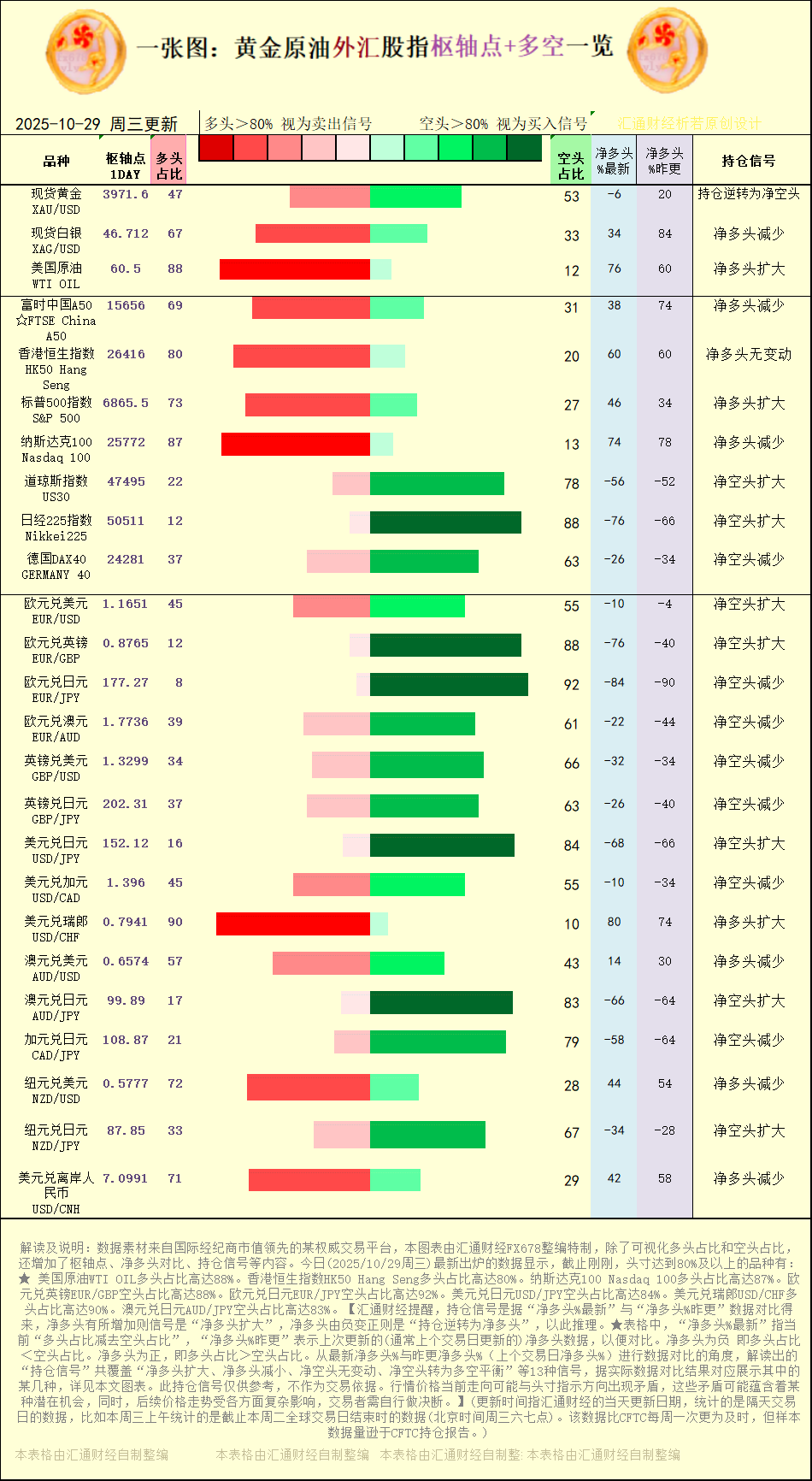A chart summarizing "pivot points + long/short position signals" for gold, crude oil, forex, and stock indices on October 29, 2025.
2025-10-29 11:06:51
Among the signals of changes in positions, there were 3 instances of increased net long positions, 6 instances of decreased net long positions, 7 instances of increased net short positions, and 7 instances of decreased net short positions. The following commodities had positions of 80% or more: US WTI Crude Oil (88% long), Hong Kong Hang Seng Index (HK50) (80% long), Nasdaq 100 (87% long), EUR/GBP (88% short), EUR/JPY (92% short), USD/JPY (84% short), USD/CHF (90% long), and AUD/JPY (83% short).

[Chart: Pivot Points and Long/Short Position Signals for Gold, Crude Oil, Forex, and Stock Indices. Source: FX678 Special Chart. (Click image to enlarge)]
The following currencies saw a decrease in net short positions: German DAX 40, Euro/Japanese Yen EUR/JPY, Euro/Australian Dollar EUR/AUD, British Pound/US Dollar GBP/USD, British Pound/Japanese Yen GBP/JPY, US Dollar/Canadian Dollar USD/CAD, and Canadian Dollar/Japanese Yen CAD/JPY.
The following currencies saw an increase in net long positions: WTI crude oil, S&P 500, and USD/CHF. The following currencies saw a decrease in net long positions: XAG/USD, FTSE China A50, Nasdaq 100, AUD/USD, NZD/USD, and USD/CNH.
FX678 reminds you that the position signals are derived by comparing the latest "net long %" and yesterday's "net long %". An increase in net long positions indicates an "expansion of net long positions", while a change from negative to positive indicates a "reversal of positions to net long positions". In the table, "latest net long %" refers to the current "long percentage minus short percentage", and "yesterday's net long %" represents the last updated (usually the previous trading day's) net long position data for comparison. A negative net long position means the long percentage < the short percentage. A positive net long position means the long percentage > the short percentage. From the perspective of comparing the latest net long % with yesterday's net long % (previous trading day's net long %), the interpreted "position signals" cover 13 types, including "expansion of net long positions, decrease of net long positions, no change in net short positions, and a shift to a balance between long and short positions". Some of these signals are displayed based on the actual data comparison results, as detailed in the charts in this article. This position signal is for reference only and should not be used as a basis for trading. The current price movement may contradict the direction indicated by the position signal. These contradictions may contain potential opportunities. Furthermore, subsequent price movements are influenced by various complex factors, and traders must make their own decisions.
[The trading instruments covered in this chart include: spot gold, spot silver, US crude oil, FTSE China A50, Hong Kong Hang Seng Index, S&P 500 Index, Nasdaq 100, Dow Jones Index, German DAX 40, EUR/USD, EUR/GBP, EUR/JPY, EUR/AUD, GBP/USD, GBP/JPY, USD/JPY, USD/CAD, USD/CHF, AUD/USD, AUD/JPY, CAD/JPY, and NZD/USD.]
- Risk Warning and Disclaimer
- The market involves risk, and trading may not be suitable for all investors. This article is for reference only and does not constitute personal investment advice, nor does it take into account certain users’ specific investment objectives, financial situation, or other needs. Any investment decisions made based on this information are at your own risk.





















